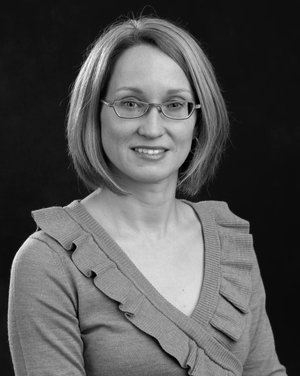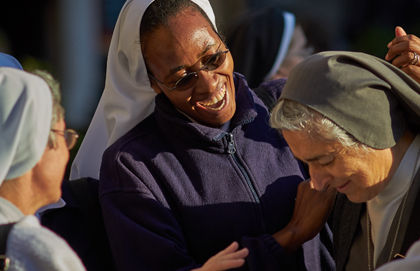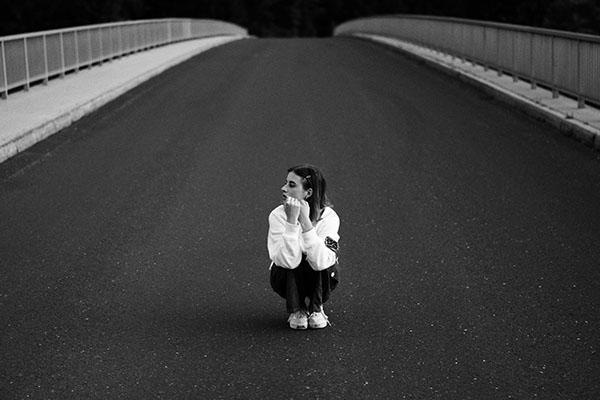In the last of our three conversations on consecrated life in Canada, historian Heidi MacDonald considers the demographics of congregations of women religious during the past 160 years and traces their precipitous decline to a disturbing loss of community in society at large.
Peter Stockland: One of the things that struck me was the baseline that you drew showing that although alarm bells have been ringing for a number of years about the decline in religious in Canada, in raw numbers they're not far from what they were at the turn of the last century.
Heidi MacDonald: The number is not separated into men and women religious, but the total 2012 figure is 14,792. That's roughly the same as it was in 1911. It's the same as 100 years ago.
PS:Obviously as a proportion of the total population, it's much smaller, but in terms of raw numbers… Looked at another way, I think, it contradicts the notion that consecrated lives, monastic lives, religious orders, were purely a function of New France, that every second person you bumped into in Ville Marie was a nun or a priest. In fact, as you've pointed out, the real growth in the number of religious came in the mid-19th century to the mid-20th century, right?
HM: Yes. It peaked in, say, 1965. The number we use is approximately 66,000; that's just nuns, women religious. I'm not including men. Sixty-six thousand in 1965. The rise in absolute numbers is definitely from — I think you could take it back to Bishop Bourget in Montreal, so the 1850s and '60s up to 1965. That's a straight upward curve.
PM: Are you able to say what was driving that? Because it goes against our other popular conception of Canada as moving from an agrarian base to a more industrialized, urban country. I think we've actually been a predominantly urban people since the late 1920s, haven't we?
HM: 1931. The first census year that we're more urban [than rural] is 1931. I wouldn't say it goes against that because these women were working predominantly in schools and hospitals, and there are going to be more of those in urban areas.
I think it parallels the rise of urbanization. It's not the only way to look at it, but I think it's not incongruous with urbanization.
PS: So the idea that a religious life, a contemplative life, in broad terms a monastic life, is sentimental and pastoral is, in fact, not borne out by the numbers. There is a parallel growth between the industrialization of the country, or its urbanization, and the number of religious?
HM: Well, women religious, vowed women, are meant to be contemplative first, right? Then they have apostolates. You might say that they have dual lives or dual professions even because they train as contemplatives and then they usually train in a career. Their main work, really, in this social history context is as religious workers. You referred to them as contemplatives, where I would see them as apostolates first. They're working in the world, predominantly. The number of contemplatives is very small compared to the number working in schools and hospitals.
PS: But, in fact, as you say, urbanization and the growth of a robust number of women religious seem to go hand in hand.
HM: I think so, and it can still be in rural areas, too. You might tie it more to population growth generally than the urban population growth because it's both urban and rural where these women are teaching. Slightly more urban, though. If you think of it, there's not going to be a nun in a one-room schoolhouse, right? That's not how they would operate. They would operate as, say, a minimum of three nuns.
PS: Because they would be a community?
HM: They wouldn't live on their own. That's why I'm thinking more urban. Of course, the farther back you go, the poorer the travelling conditions, the more likely their school's going to be in their convent. That makes it more urban. You're making me think in a way I haven't thought before.
PS: At the same time, as it's reaching that peak and those forces are helping that growth, something is appearing that shows the growth during the 1940s.
HM: Yes, it seems to begin in the 1940s. But, having said that, I would also say that demand always exceeded supply.
PS: Okay, so even with the robust growth, it wasn't enough to sustain what they were doing?
HM: Well, in archives, I've seen the number of requests from bishops. Mother superiors received requests on a weekly basis: Please take over this school; please set up this school; please set up a hospital or take over a hospital; please send 12 sisters; please send 15 sisters; please send 35 sisters. They could never fulfill the number of requests. In studying 20th century nuns, I've seen archive copies of letters from mother superiors to bishops saying, "We've thought about this. This is the third request we've seen this month; we just can't do it."
PS: Why couldn't they do it? In a normal, simpleminded economic way, wouldn't you say, if there's this demand out there and if you're a strong, robust organization, you should be able to attract the necessary people to fulfill demand. What was the obstacle?
HM: Well, picture a province. I know the Maritimes best. Picture a group of say 75 nuns in Prince Edward Island in 1930. They're labour. It's not free labour, but it's less expensive labour than if you had to hire, say, a nurse and pay the going rate. A woman religious could do it less expensively. The result is insatiable demand for that labour at a reduced rate. And it's possibly more skilled labour than is otherwise available. Congregations could send women for training in a way that other women could not be sent for specialized training out of province. Say a hospital in Charlottetown needed an X-ray technician. A congregation of women religious could arrange for that training. A sister could go to Halifax and stay with another religious organization.
PS: Whereas the local hospital might not have the funds to, say, send a layperson...
HM: Nuns have that practical infrastructure.
PS: Now, see, my libertarian friends would say that that's a market condition that should actually create the conditions for nuns to ultimately take over because their production costs are so much lower. They simply couldn't...
HM: But it's a big deal to take the vows of poverty, chastity and obedience. That's what seems harsh; but that, I would say, is what limits the number of women who would enter religious life.
PS: So the conditions of the time allowed for a flourishing, but the movement towards individual liberty, autonomy, would have worked against it?
HM: You are asking me to think in a really different way. Your question is why weren't there more women religious?
PS: Well, not so much why weren't there more but why wasn't the growth rate that had been established sustainable in light of opportunity and demand? Was it a change in social values that made it unsustainable?
HM: Are you talking now in the '60s?
PS: Right. I guess what I'm trying to get at, just in my own mind, is whether the growth was a curve or a Pike's peak. Suddenly there's a jump-up of people.
HM: From 1850 to 1965, it's an upward curve. Then there's a very clear peak and a fall.
PS: Yet you point out that the first alarm bells weren't officially rung, at least publicly, until about 1973?
HM: That's right. I think that there was a worry that would create a lack of confidence, and also a hope that this storm could be weathered and everything would fall back into place. By 1973, that's getting close to a decade. Vatican II ended in 1965, so it's close to a decade after Vatican II and the decline [in religious] is not righting itself at all. I think the largest year for departures from religious orders is 1973. I believe it was about 800. It's not a coincidence that's the year when they say, "Okay, we're really in trouble."
PS: Now, they would have seen the tide rushing out in the 1960s, but had the congregations and the superiors seen it starting before Vatican II or was it something that really just kind of burst in their faces?
HM: In the 1940s, '50s and '60s, they were unable to keep up with requests for their labour. On the other hand, these were some huge requests, so it's not surprising that they couldn't keep up. At the same time that they were receiving a lot of requests, the numbers kept rising. The Sisters of Charity in Halifax had 100 entrants a year, and that wouldn't be as large as some Quebec congregations. Even in the 1950s, women were entering in larger numbers than ever. Numbers were going steadily up, but it's still not enough to meet all the demands.
PS: It was a period when nuns were very much a part of popular culture, or at least images of them were, weren't they? There was the Singing Nun from France; Sally Field was the Flying Nun...they were part of the cultural iconography.
HM: It still is the case in a lot of ways. If you go into a gag gift store, you're likely to see a bowling nun or nunzilla. The stereotypes still exist.
PS: Yet that stereotype was not enough to sustain the religious orders after the mid-1960s.
HM: It might have gone against them even, right? Because [giving up] the habit...this was a big deal. It was not entirely giving up of the habit. No one was forced to give up the habit, but they were encouraged. It happened with Vatican II. There are layers of things that start to happen in the mid-1960s, including giving up the habit, which is seen as a part of the reason for departures.
Some nuns didn't like that they were giving up the habit because it was a loss of identity. Why join a religious congregation if you aren't going to dress differently and have a clearly different life than if you were a regular teacher?
PS: There's an order called the Sisters of Life, and they have made a point of dressing in traditional habits, in very traditional garb, and they take a lot of abuse from other orders for it. Still, all these years later, it's a point of irritation for a lot of women that they're dressed like that.
HM: It's a controversy, but there are lots of congregations where a few people still wear a habit, and so within congregations it's tolerated, in my experience.
PS: It was more than the basis of a series of really bad puns. It was a very significant crisis of identity.
HM: I find it so striking to think about, say, a 50-year-old woman who'd worn a habit for 30 years not wearing a habit. There are all kinds of issues. You haven't styled your hair for 30 years. It's not a small thing. Or buying clothes off the rack. There were modified habits — what were referred to as controlled modified habit experiments — where the habits were just a little shorter. I think it would be pretty uncommon to go from a habit to street clothes. Still, I think very striking. For an individual, it could promote a real identity crisis.
PS: You said something that really struck me and I thought it was a very brave thing to say, but you said that feminism, if I'm quoting correctly, was delayed in Quebec because of the strength of at least the superiors and the leadership among women religious.
HM: It's a theory, and another scholar said it in the 1980s. She said, "Maybe that's why feminism was so delayed in Quebec [because] the women who would have led a feminist movement in Quebec were probably in convents enjoying leadership roles."
PS: Do you think that is a good thing or a bad thing? Or is it for you as a researcher just part of history?
HM: I see feminism and women religious' work and organization as very connected. I think that, in fact, women religious in the post-Vatican II era need to be understood in the context of feminism: their influence on feminism and feminism's influence on them. They're self-governing institutions of women, so I think that's feminism. How could they not be seen through a feminist lens? Some people define feminists in a more radical way than I would, so we all bring our definition of feminism. But you can't understand women religious without understanding feminism and vice versa in Canada. Not just in Quebec, but anywhere.
PS: The sort of sidewalk view would be that religious life, particularly the life of women religious, equals subservience, so therefore does not equal a feminist ideal.
HM: There you go. So they're leaders, and it's not just the Mother Superior. Today we usually say leadership team or congregational leader. They're in major positions of leadership, and if you compare them to other women leaders, whether it's a university — and some of them, of course, were also university presidents — that's feminist to me.
I would say that during this post-Vatican II crisis, there were opportunities that were unimaginable pre-Vatican II, and that is when it became obvious that the work in schools and hospitals — I mean the complete running of a hospital or staffing of a school — couldn't be sustained.
When it became obvious that such work couldn't be sustained, combined with the Vatican II directive to work more directly with the poor and to return to the original intention of [a congregation's] founder and with the demographic reality, this created an opportunity that sisters could consider what they'd like to do, consider their own gifts and how they would like to use them.
That's new to Vatican II because before that congregations had such human resource commitments to schools and hospitals that there was very little opportunity for a small-scale additional mission or apostolate. When women are asked to consider their gifts in the post-Vatican II era, they come up with some really interesting things. In the post-Vatican II era, you don't see a big shift into one new area. It's just hundreds of individual apostolates. There is a big increase in parish work, but then the list is almost infinite, from massage therapists to, I just heard of a doula, to canon lawyers to foster parents. A sister [who's] a teacher has applied to be a foster parent.
When you ask people to consider their gifts, it's not surprising that there's a huge list. So that's the opportunity that was unimaginable pre-Vatican II. Some really impressive work could be done with the poor that couldn't be done when [nuns] were only running a school.
PS: So they move from a monoculture to ecologically sustainable environments for women religious. Does that bode well, then, for the future? I'm guessing we'll never get to the demographic bulge that existed at the beginning of the 20th century — and maybe don't even want to — but does it bode well for the congregations? Or is it a rather bleak picture?
HM: Well, I would think that could be an attraction to a woman considering religious life today: that she would have the opportunity to contribute in a way that suited her, in a way that she most wanted to contribute.
PS: What would be her entry point for that, though? Since chances are that even if she went to a Catholic school in one of the few provinces that still have them, it's not a great deal different from a public school. Her contact with religious sisters would be minimal to none. What would be the entry point, for example, among the university population that you deal with? What would be the opportunity for a woman to even consider that this might be a life she would choose?
HM: I don't know if you're thinking literally, but a website. All of these congregations have websites, and if they're considering taking new members — and some aren't — there will be a link on the site. There are discernment programs. There are weekends where someone could learn about the congregation. Entering religious life, in my mind, has always had at least loose comparisons to finding a university. You don't necessarily go to the university that's geographically closest. In the same way, it's been fascinating to me to see that, even in the late-19th century, women might join a religious congregation a thousand miles away because there was some connection, some call. She could also talk to her priest. Today, websites, that's what I pitch with my students. I had a student a couple of years ago who — this is the only time in my 14-year career — wanted to be a nun. She'd been in a discernment program in the States, a conservative order. I'm sure she started with a website.
PS: Did she actually enter the congregation?
HM: She didn't. I didn't hear from her for a while, and then a friend of mine said she was at her shower. She fell in love with a farmer and got married. I was pretty surprised. I thought it was a done deal for her. But the congregations, most of them have programs. They're still thinking of formation. They have not forgotten the formation. It's a rare thing to get an entrant, but they still do. It happens, maybe once every 10 years, but...
PS: Once every 10 years? That doesn't sound sustainable.
HM: Here's a figure I think is so striking. In 1965, which is the end of Vatican II, the average age of women religious in Canada was 48. Today, it's 78. It's a steady climb that explains some of the move away from institutional work.
PS: Sisters are basically going into retirement, and there's nobody coming up behind?
HM: Right. Now in retirement, they do all kinds of work, except for running schools. Retirement age in schools is 65, so they do work in their own communities. They do parish work. They all have jobs, in my experience, unless they're very ill.
PS: That particular dynamic is not specific to women religious, is it? It happens in just about every industry you can imagine.
HM: That's our age pyramid shifting, and I think it connects to community in the sense that you are sharing this experience. As a society, we're not as interested in community anymore. Joining a religious congregation and living with a group of people is not that attractive. I think we have a lot to learn about community.






